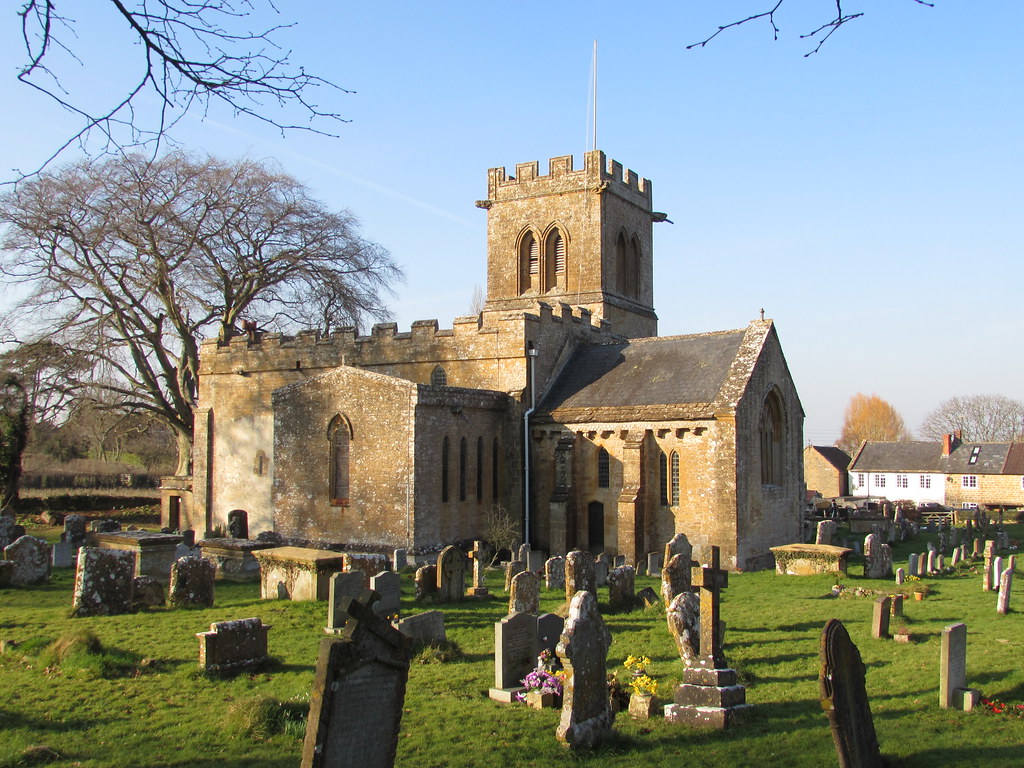
Stoke-sub-Hamdon (Somerset): The Church of St Mary; via Flickr: https://www.flickr.com/photos/13706945@N00/26592053208
14893 Private Walter George Ralph of the 6th Battalion, Somerset Light Infantry was killed-in-action on the Somme on the 16th September 1916, aged 27. George Ralph was also a bellringer at Stoke-under-Ham (Somerset) and a member of the Bath and Wells Diocesan Association of Change Ringers.
The phase of the Battle of the Somme that became known as the Battle of Flers-Courcelette commenced on the day before Private Ralph’s death. This post will first provide some background information on Private Ralph’s unit and its activities during the Battle of Flers-Courcelette, before going on to outline what it has been possible to find about about George Ralph’s life and family from genealogical databases and other sources [1].
The 6th Battalion, Somerset Light Infantry:
The 6th (Service) Battalion, Somerset Light Infantry had been formed at Taunton in August 1914 and trained at Aldershot and at Witley Camp, near Godalming. Until June 1918, the battalion formed part of 43rd Infantry Brigade in the 14th (Light) Division [2]. The other infantry battalions in the 43rd Brigade were the 6th Battalions of the Duke of Cornwall’s Light Infantry and the King’s Own Yorkshire Light Infantry, and the 10th Battalion, Durham Light Infantry [3].
On the 21st May 1915, the battalion left Aldershot for the front, sailing that evening from Folkestone to Boulogne-sur-Mer. They would spend their first months on the Western Front in the Ypres sector, taking part on the 25th September 1915 in the Second Attack on Bellewaarde, one of several diversionary attacks that were intended to distract German attention away from the much larger British offensive being undertaken further south at Loos-en-Gohelle. The battalion would stay in the Salient until February 1916, when they would move to the Arras sector, where the 14th Division would take over trenches from the French 33rd Division [4]. The battalion would remain at Agny until late June 1916, when they would take over trenches at Saint-Laurent-Blangy. Towards the end of July 1916, the 14th Division were relived in the Arras sector by the 21st Division, who on the 1st July had taken part in the attack on Mametz. The 6th Somersets would then move south from Arras to join General Sir Henry Rawlinson’s Fourth Army on the Somme front, where on the 18th August, they would take part in a attack on the ‘Brewery’ complex east of Delville Wood. After a short spell resting west of Amiens, the battalion returned to the Fourth Army area when the third major phase of the Somme offensive commenced on the 15th September 1916.
The Battle of Flers-Courcelette:
For what became known as the Battle of Flers-Courcelette, eleven British Divisions would attack on a broad front from north of the Albert-Bapaume road to the junction with the French near Maurepas. The battle is today mostly remembered for the first use of a new British weapon, the tank. The offensive would involve both of the British Armies on the Somme. While General Sir Hubert Gough’s Reserve Army was intended to have a largely supporting role at the start of the battle, the main thrust of the offensive was supposed to come from the Fourth Army south of the Albert-Bapaume road. Rawlinson had three Army Corps in the line, each with three Divisions. III Corps (Lieutenant-General Sir William Pulteney), comprising the 15th (Scottish), 50th (Northumbrian) and 47th (2nd London) Divisions, held the northern part of the sector around the Bazentins, facing what was left of the fortified village of Martinpuich and the parts of High Wood that remained in German hands (the wood had been bitterly fought over since the latter part of July). On their right were XV Corps (Lieutenant-General Sir Henry Horne), with the New Zealand Division, the 41st and 14th (Light) Divisions, east of Longueval and Delville Wood, facing the villages of Flers and Gueudecourt. The right flank was held by XIV Corps (Major-General the Earl of Cavan), with the Guards Division, the 6th and 56th (1st London) Divisions in the area around Ginchy and Guillemont, facing the villages of Lesbœufs and Morval. Any breakthrough was expected to come in the XIV Corps sector, and two cavalry divisions were brought up ready to exploit it should the opportunity occur.
The 14th Division on the 15th September 1916:
In the 14th Division sector, the plan was for the 41st Brigade to attack and capture the Division’s 1st and 2nd objectives, following which the 42nd Brigade would pass through and capture the 3rd and 4th objectives – which were respectively around Bulls Road (the Flers – Lesbœufs road) and the fortified village of Gueudecourt itself. The village was protected by two major trench systems: Switch Trench (Switch Line) and Gird Trench. Zero was set for 6.20, and the attack would be led by the 8th Rifle Brigade and the 8th King’s Royal Rifle Corps (41 Brigade), with a preliminary attack that would be supported by a single tank (D.8).
The day started well. The preliminary attack cleared trenches in an awkward salient just east of Delville Wood. After Zero, the 8th Rifle Brigade and the 8th King’s Royal Rifle Corps (KRRC) managed to capture several more trenches and occupy the Switch Line. They were then followed by the 7th Rifle Brigade, who were able to occupy Gap Trench, with the 7th KRRC on their left.
In the meantime, the lead battalions of the 42nd Brigade had moved up east of Delville Wood, with the 9th Rifle Brigade and the 9th KRRC on the right and the 5th King’s Shropshire Light Infantry and the 5th Oxford and Buckinghamshire Light Infantry to their left. The lead battalions passed over Gap Trench to attack Gird Trench, the 3rd objective. What happened next is described by the British Official History [5]
The 9/Rifle Brigade lost heavily by enfilade machine-gun fire from the right as it approached Bulls Road, and came to a halt in shell-holes some distance short of the objective. Lieut.-Colonel T. H. P. Morris had been mortally wounded, and every other officer hit except one very junior subaltern. On the left the K.S.L.I. became somewhat dispersed in passing through the foremost troops of the 41st Brigade, and German machine guns enfiladed the battalion from the left before it had passed Gap Trench.
Like the Rifle Brigade, it was brought to a halt before it reached the road, and began to dig in. Following the Rifle Brigade came the 9/K.R.R.C., which lost Lieut.-Colonel E. W. Benson, killed, in the early stages of the advance, and eventually overtook the leading battalion. On the left, the Oxford & Bucks L.I., which had overtaken the Shropshire, linked up with the 9/K.R.R.C. at the Ginchy – Gueudecourt road. Although exposed to effective shell-fire all the way, the brigade had carried the advance of the 14th Division beyond the divisions on its flanks, and now every movement drew machine-gun fire from right and left.
The advance was then supposed to continue towards Gueudecourt at 10.50 am, following a artillery barrage [6]
At the appointed time, 10.50 a.m., the corps barrage began to lift from the Gird trenches, but the 14th and 41st Divisions were in no condition to follow up the success they had won. On the right of the 14th Division, the 9/Rifle Brigade, supported by the 9/K.R.R.C., endeavoured to advance across Bulls Road at 11.20 a.m. in order to attack the Gird trenches, but the movement was stopped by machine-gun fire from Gird Trench near the right boundary of the corps. Reduced to about 350 rifles in all, the two battalions then improved a shell-hole position running south-eastward to Gas Alley, where some men of the 1st Guards Brigade assisted to prolong the defensive flank. The left was in touch with the Oxford & Bucks L.I. on the third objective at the Ginchy – Gueudecourt road, for by this time the Oxfordshire and K.S.L.I, had reached Bulls Road on the left portion of the divisional front.
Few Germans could be seen in the Gird trenches, which appeared to have little wire in front of them, so that a further advance appeared feasible. Appeals for reinforcements had been made, and Major-General Couper’s reserve, the 43rd Brigade, began to arrive at Montauban soon after 11.30 a.m.; but its leading battalion was still some 3½ miles behind Bulls Road. Artillery assistance was not easy to provide, since many field batteries were on the move to forward positions, coming under heavy shellfire as they did so and suffering much delay through the heavy state of the ground. The only tank (D5) still in action on the divisional front – the machine which had arrived too late to play its part in the preliminary operation east of Delville Wood – did, indeed, reach Gueudecourt before noon and engage a German battery, forcing the gunners to take shelter in a dug-out. After cruising about whilst waiting for the infantry to advance, the machine withdrew, but was then shelled by the battery and set on fire.
In the afternoon, the Corps commander ordered new attacks on Gird Trench [7]:
At 2.40 p.m. Lieut.-General Horne telephoned to the 14th and 41st Divisions to say that the corps artillery was beginning a fresh bombardment of the Gird trenches and Gueudecourt, and that he would give two to three hours’ notice if a fresh advance were to be made. He then informed the Fourth Army that he proposed to attack at 5 p.m., and asked if the reserve brigades should be so used even if the Guards made no further effort to get Lesboeufs; he only had one division in reserve. Soon after 3 p.m. General Rawlinson, who by this time had been informed of the general situation on the Army front, cancelled all further attacks for the day – it was understood that the advance was to be resumed on the morrow – and at 3.45 p.m. divisions were instructed that the third objective was to be linked up securely and consolidated, under cover of a field artillery barrage.
During the afternoon parties of Germans trickled steadily forward into the Gird trenches, many advancing in open order, from the direction of Le Transloy, less than two miles east of Gueudecourt.
[…]
Along the whole front of the XV. Corps the German artillery fire increased as the day wore on, and at 6.45 p.m., in the fading light, a half-hearted counter-attack down the Gueudecourt — Ginchy road was repulsed by the fire of the advanced troops of the 14th Division. Soon afterwards another enemy attempt, coming this time from the north-east, drove in some posts of the Irish Guards (1st Guards Brigade), which had by this time been established beyond the second objective, and thereby caused the 14th Division to strengthen its defensive flank in Gas Alley. After darkness fell, the 43rd Brigade, from reserve, began the relief of the 42nd Brigade in readiness for the resumption of the attack next morning.
The attack, therefore, had stalled. It would be up to the 43rd Brigade to take on the offensive.
Amongst the dead of the 9th King’s Royal Rifle Corps on the 15th September was another Somerset bellringer: Rifleman Albert Budd, from Curry Rivel. Further south, in the 6th Division area, Private George Bye of the 8th Battalion, Bedfordshire Regiment, a bellringer from Portbury, was also killed in action in that Division’s attempt to capture the Quadrilateral.
The aftermath of the 15th September:
The results from the first day of the 15th September offensive were mixed. North of the Albert-Bapaume road, the Canadian Corps (part of Gough’s Reserve Army) had managed to capture the village of Courcelette. In the III Corps area, the 15th Division had taken Martinpuich, while the 47th Division had finally managed to clear what was left of High Wood. In the XV Corps area, the New Zealand Division and the 41st Division were among the most successful units on the 15th September. The most famous example saw tank D.17, commanded by Lieutenant Stuart Hastie, advancing along the main street in Flers with the 41st Division. This was cheerfully reported in newspapers a few days later as, “a tank is walking up the high street of Flers with the British Army cheering behind” [8]. To their south, the 14th Division found it more difficult to make progress, and ended the day a long way short of Gueudecourt. Prior and Wilson attempt to explain why [9]:
This unit [14th Division] was heavily enfiladed by the machine-gunners who had wrought such devastation on the early attack of the Guards Division. The unit also had trouble locating the Switch Line, which had in fact been obliterated by the artillery. Nor could the division establish contact with the fast moving 41 Division on its left. So as the reserve battalions attempted to move forward they found both their flanks unsupported. They dug in and held their positions, but they were short of the German second line and had no chance of advancing beyond.
To the right of the 14th Division, progress in the XIV Corps sector was even more disappointing. The 6th Division were held up by the fortifications of the Quadrilateral, while the Guards Division ended the day a very-long-way short of Lesbœufs and Morval.

Headline of news item on the first use of tanks in combat. Source: Western Evening Herald (Plymouth), 18 September 1916, p. 3; via British Newspaper Archive.
With hindsight, it seems that too much faith had been placed in tanks. The first generation of tanks were slow and unreliable, and many failed to make their start lines on time — or even at all. With limited numbers available, tanks were not in a position to be a war-winning machine at that particular stage of the war. Planning for their use had also created additional problems. For example, gaps (lanes) had been left in the barrage to facilitate the advance of tanks, and this meant that infantry often attacked without the benefit of artillery protection.
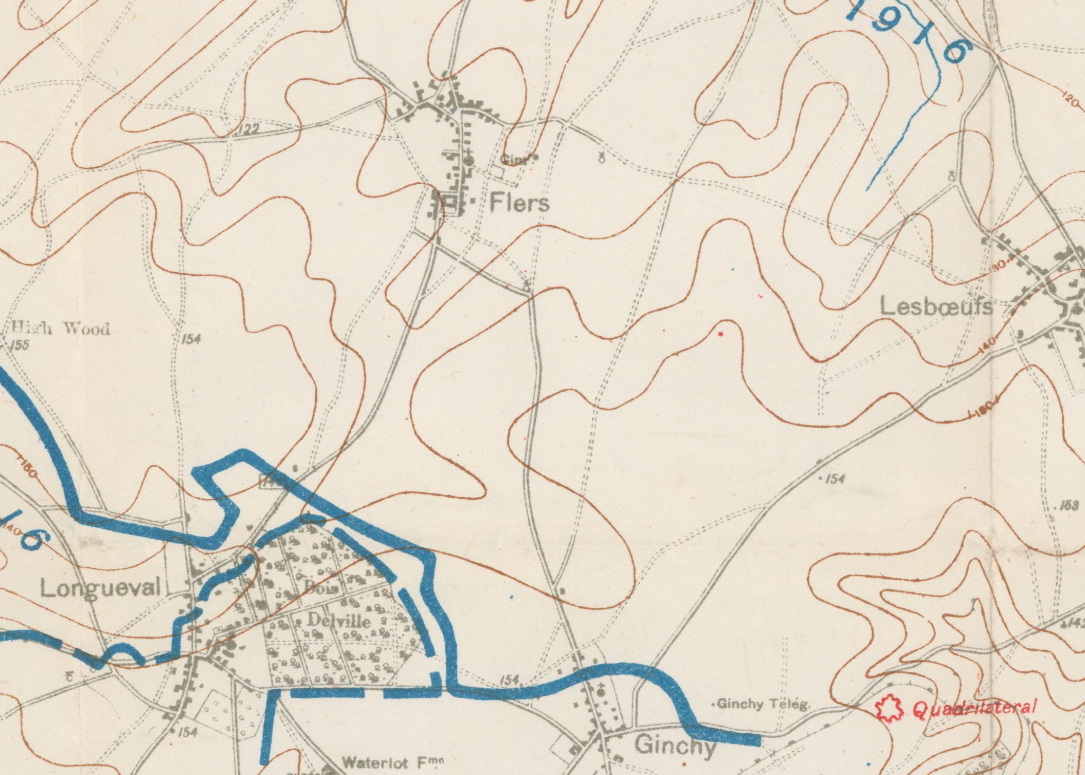
14th Division sector NW of Delville Wood, between Flers and Lesbœufs. Detail from: Map of the Somme area; Scale: 1:40000; Edition: 2; Published: December 1916; via National Library of Scotland: https://maps.nls.uk/view/101723165
The 6th Somerset Light Infantry on the 16th September 1916:
The offensive would resume on the 16th September, with Rawlinson again keen for the cavalry to be able to exploit a breakthrough. However, many units were simply not in a position to resume the offensive, with predictable consequences. Prior and Wilson explain [10]:
As for the infantry, the 6. Guards, and 47 Division were in no state to resume full-scale attacks and the remainder were in various degrees of disorder. What followed then from Rawlinson’s instruction was not a concerted attack across the whole front but the series of small-scale, sporadic actions that had become a familiar pattern after a major attack on the Somme. On this occasion they produced exactly the same results as those following 14 July – no advances for quite heavy casualties.
On the 14th Division front, as has already been mentioned, the 43rd Brigade had relieved the 42nd Brigade in its advanced positions on the evening of the 15th September. The lead battalions on the 16th September would be the 10th Durham Light Infantry and the 6th Somersets. Their objectives would be to capture Gird Trench and Gird Support, after which the support battalions from the 6th King’s Own Yorkshire Light Infantry and 6th Duke of Cornwall’s Light Infantry were supposed to pass through and capture the village of Gueudecourt itself. They would have to achieve this without the support of tanks. The British Official History provides an overview of what happened [11]:
On the front of the 14th Division (Major-General V. A. Couper) the creeping barrage was weak, and started too far in front of the infantry; the bombardment by the heavy artillery seems to have been ineffective. The 6/Somerset L.I. (Br.-General P. R. Wood’s 43rd Brigade), which formed the right of the attack, was exposed to fire from the Germans in Gas Alley, and could make little progress. Part of the battalion, however, occupied a half-dug trench which was presumed to be Gird Trench, and the capture of the latter was reported. West of the Ginchy – Gueudecourt road the 10/Durham L.I. of the same brigade was smitten by streams of bullets from front and right flank as soon as its advance began. Open country, which still contained some crops, and, with many folds in the ground, sloped down to Gueudecourt, was ideal for machine-gun defence. The foremost survivors took cover in shell-holes, and the attempts of the 6/K.O.Y.L.I. and 6/Cornwall L.I. to reinforce the front battalions only increased the toll of casualties. An order to renew the attack at 6.55 p.m. was faithfully carried out, but had no hope of success, so that the line at night showed little advance on that of the morning.
By the end of the 16th September, the 43rd Brigade were, therefore, still a long way short of Gueudecourt.
The War Diary of the 43rd Infantry Brigade (WO 95/1903/1) contains a detailed “Narrative of Operations” for the 16th September 1916, which was written by the commanding officer of the 6th Somersets, Lieutenant-Colonel Thomas Fraser Ritchie. It reveals the presence of an previously unknown German trench, which Ritchie named X.X., which significantly complicated the battalion’s attack [12]:
6th SERVICE BATTALION SOMERSET LIGHT INFANTRY.
NARRATIVE OF OPERATIONS 16th Sept, 1916.
At 4.a.m. on the 16 Sept the Battalion relieved the 9th K.R.R. in the right GUEUDECOURT Sector, which had been captured by that battalion on the previous day.
My dispositions were as follows:–
“B” Coy on right of A – A trench.
“C” Coy on left of A – A trench.
“A” Coy in B – B trench.
“D” Coy support in GUN ALLEY.
I had been told the previous evening that I was to attack on the next day and received final orders at about 4.30.a.m. on the 16th.
I sent for my O.C. Companies and issued my orders. I have not a copy but my arrangements were:-
The attack to be made in two waves by the companies in the front line. Companies to right incline on leaving our trench.
Company objectives were GIRD SUPPORT as follows:-
“B” Coy N.33.c.4.3. to N.33.c.1.8.
“C” Coy N.33.c.1.8. to N.32.b.7.2.
“A” Coy N.32.b.7.2. to N.32.b.3.8.
“D” Coy to move to A.A. Trench at zero and when GIRD SUPPORT had been captured to GIRD TRENCH.
Each company to leave a cleaning up party of 1. Bombing Squad and 6.men in GIRD TRENCH and then follow the barrage to GIRD SUPPORT.
Both trenches to be consolidated.
Zero at 9.25.a.m.
There is a trench which I have called X – X on sketch. I do not know if it had been occupied by the 9th K.R.R. on the previous day, but I imagine not. At any rate I was unaware of its existence. This is an unfinished German trench – right and seemed old, but a lot of new work had been done on the left and centre.
There is a slight ridge between AA and X.X. trenches.
At zero the men went over, but instead of reaching GIRD TRENCH the right of “B” Company reached the right of X.X., the other companies taking the remainder of the trench between this point and the Sunken Road. Some six Germans were captured on the right and about a hundred of the enemy ran away. Everyone thought they were in GIRD TRENCH and I was under the impression until the evening. “C” Company advanced and dug in on a line some 50.yards from GIRD TRENCH. “A” Company dug in about 100.yards North of X.X.Trench, with their left on the Road. On comping over the ridge between A.A. and X.X. trenches the men came under M.G.fire from the North and East and lost heavily. It was impossible for them to advance further. At 9.50.a.m. I received a message from “B” Coy on right saying that they could not advance owing to the number of the enemy, who were bombing them from GIRD TRENCH. As I had two Companies of the K.O.Y.L.I. in close support I sent “D” Company to their assistance, but on account of the M.G. fire they were unable to advance beyond X.X.Trench.
All Companies remained in those positions during the day and I reported that GIRD Trench had been taken but that I could not advance further.
A attribute the failure of this attack to the following causes:-
(1) Insufficient time to reconnoitre the ground in front.
(2) Insufficient Artillery preparation – everyone agrees that GIRD Trench and GIRD Support were practically undamaged.
(3) A weak Field Gun barrage when attacking.
(4) M.G.fire. This was very heavy and I think came from the following points:- GUEUDECOURT, about N.27.c.central, GIRD Trench at about N.32.a.8.2., or possibly East of these trenches. Also several N.C.O’s report that there is a strong point or several Machine gun emplacements about N.32.b.2.0.
At 3.50.p.m. I received a message informing me that the Division on our right [the Guards Division] was to attack at 4.p.m. and instructing me to co-operate if I thought there was a fair chance of doing it successfully.
I did not think there was such a chance for the following reasons:-
(1) I had no time to make any preparations of to issue orders.
(2) The artillery preparation was still inadequate.
(3) M.G’s were as active as ever.
I therefore did not attack.
At 6.20.p.m. I received orders to renew the attack at 6.55.p.m. assisted by two Companies 6th K.O.Y.L.I. who advanced at 6.55.p.m. reached X.X.Trench my men were still there. Most of my companies attempted to advance but the M.G. fire was too strong and the attack broke down. I later withdrew all men to the X.X. line and with the assistance of 1.Company K.O.Y.L.I. held this line and handed it over as the front line when relieved early the following morning.My losses were 17.officers and 383.Other Ranks.
As every Company Officer became a casualty, most of them during the first attack, it is probable that either snipers or certain M.G’s were toldn [sic] off for this purpose. I also lost a lot of N.C.O’s.
The German artillery fire was extremely feeble. During the evening attack they did not put on a barrage and relied entirely on M.G’s. Practically all my casualties were from M.G.fire.
Without a thorough Artillery preparation I consider that an attack on this position is not likely to succeed. The ground is pecularly [sic] well suited to defensive M.G.action, and the guns are difficult to locate.(Sgd) T.F.RITCHIE
Lieut-Colonel.
Commanding 6th Service Battalion
Somerset Light Infantry.19.9.16.
The “Narrative of Operations” is accompanied by a sketch map that locates the key trenches running parallel to Bulls Road: Trenches A-A and B-B to its south, on both sides of the sunken road (Watling Street); Trench X-X to the north, possibly linking with Gird Trench at an angle.
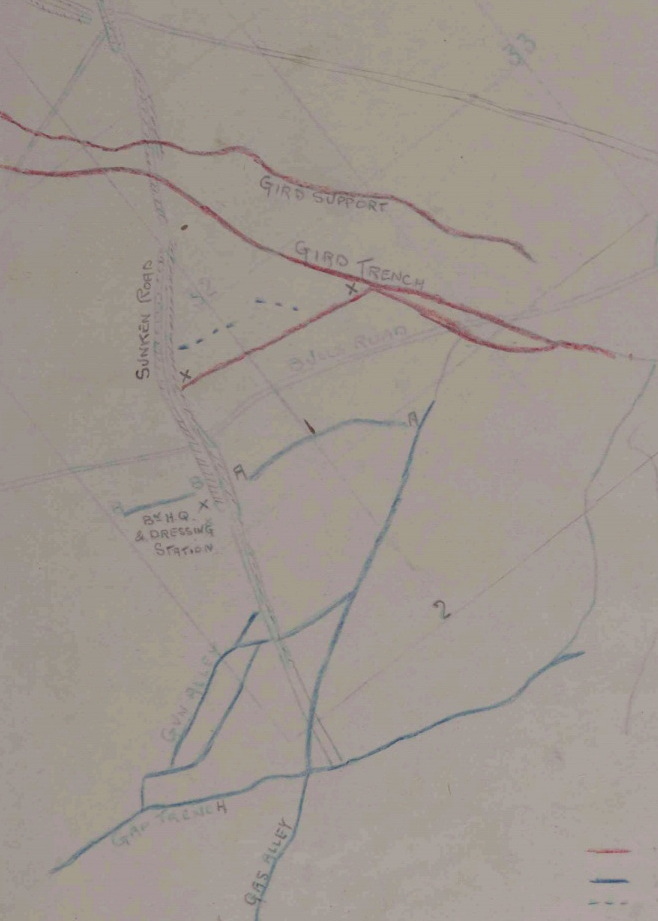
Detail from sketch map attached to the Narrative of Operations of the 6th Somerset Light Infantry on the 16th September 1916. Source: WO 95/1903/1, 43rd Infantry Brigade War Diary, The National Archives, Kew. © Crown Copyright
Casualties:
Private W. G. Ralph must have been one of the 400 casualties recorded by Lieutenant-Colonel Ritchie in his “Narrative of Operations.” The database of the Commonwealth War Graves Commission contains the details of 156 members of the 6th Somersets that died between the 15th and 20th September 1916. Of these, the vast majority (129) are commemorated on the Thiepval Memorial to the Missing of the Somme. The others are buried in cemeteries all over the Somme area, including: Guards’ Cemetery, Lesbœufs (10, including Private Ralph); Combles Communal Cemetery Extension (6); Heilly Station Cemetery, Méricourt-l’Abbé (3); Dartmoor Cemetery, Bécordel-Bécourt (3); Peronne Road Cemetery, Maricourt (2); A.I.F. Burial Ground, Flers (1); Delville Wood Cemetery, Longueval (1), and Sucrerie Military Cemetery, Colincamps (1).

Bécordel-Bécourt (Somme): The grave marker of Sgt H. Turner, 6th Somerset Light Infantry, in Dartmoor Cemetery, Bécordel-Bécourt; via Flickr: https://www.flickr.com/photos/13706945@N00/49184496281
The dead included at least one other inhabitant of Stoke-under-Ham: Sergeant Harry Turner died of wounds on the 17th September 1916 and is buried in Dartmoor Cemetery, Bécordel-Bécourt. Sergeant Turner’s death was recorded in the Western Chronicle on the 3rd November 1916 [13]:

Photograph of Staff-Sergt. H. C. Turner, 6th Somersets, in the Western Chronicle, 3 November 1916, p. 5; via British Newspaper Archive.
STOKE-UNDER-HAM.
We publish a photo of Staff Sergeant H. C. Turner, S.L.I., who died from wounds received in action on September 17th. When quire a lad Sergt. Turner joined the local Company of the Boys’ Brigade and because of his aptitude for drill and discipline and devotion to his duties he was promoted to the rank of sergt. At the outbreak of the war he was amongst the first of our young men to respond to Lord Kitchener’s appeal for men to increase the strength of His Majesty’s Forces. He joined the Somersets and was soon marked out for promotion. He qualified as a Sergt. Instructor, and volunteering for service at the Front, was sent out there, and on Sept. 16th was made Staff Sergt. On going into action the day after his promotion he received the wounds which proved fatal. Thus was a promising career cut short and another young hero yielded up his life for England’s honour and Europe’s freedom.
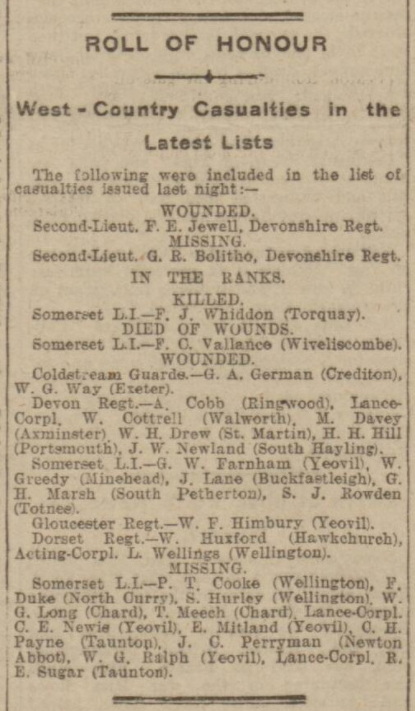
Roll of Honour containing the name of Pte. W. G. Ralph amongst the ‘missing.’ Source: The Western Times, 3 November 1916, p. 8; via British Newspaper Archive
Private Ralph was at first posted missing. In February 1917, he was mentioned in a list of Stoke dead and missing that were commorated in a memorial service held at the Congregational Church [14]:
MEMORIAL SERVICE IN HONOUR OF FALLEN HEROES.
At the Congregational Church on Suday evening a memorial service was held in honour of the Stoke heroes who have fallen in battle during the last few months. There was a large congregation present to pay tribute to the memory of the brave lads who had yielded up their lives in the great struggle in which Britain is engaged in. The preacher was Mr J. J. Bell, who took as the texts of his discourse John xvl.13, “Greater love hath no man than this, that a man lay down his life for his friends,” and I. Tess. Iv., 13, “I would not have you to be ignorant, brethren, concerning them which are asleep.” After fiving a thoughtful exposition of his texts, the preacher went on to speak in eloquent and appropriate terms of the young men who had been connected with the Sunday-school and Boys’ Brigade who had responded to their country’s call and made the great sacrifice in the present war. Their names were:- Walter Gomm, Harold Rice, Edward Gillman, Harry Turner, Courtney Isaacs, Gilbert Trott, Ben Gaylard, Bert Clarke and Henry Hamlin. The following Stoke lads were reported missing:– George Ralph, Austin Keetch and Frank Boon. Mr Bell fittingly expressed the sympathy of the officers of the church with the relatives of those fallen and missing heroes in their time of sorrow. During the service the choir sang an anthen, entitled, “Hymn of the Homeland,” the solo of which was feelingly rendered by Mrs S. Waterman. During the taking of the offertory Mr P. A. Southcombe gave a tasteful rendering on the organ of Mendelssohn’s “Rest in the Lord.” A memorial hymn was also sung with sympathetic taste by the choir and congregation. The rendition of the “Dead March” by the organist, accompanied by drummers of the Boy’s Brigade, was very effective and deeply moved the congregation. The “Last Post” was sounded by a bugler of the Brigade Band. The service throughout was of a most impressive character, and will, undoubtedly, find an abiding place in the memories of all present.
The confirmation of Private Ralph’s death was received by his parents a few months later, as reported in the Western Chronicle of the 27 July 1917 [15]:
WHAT OUR BOYS ARE DOING.
[…]
Mr and Mrs J. Ralph, of East Stoke, have received intimation from the War Office that their son, George Ralph, who was reported missing some months ago, was killed in action on September 16th, 1916. The deceased was 26 years of age and was among the first to volunteer. Much sympathy is felt for Mr and Mrs Ralph in their sad loss.
Commemoration:
After the war, the body of Private George Ralph, together with that of a later burial – 1514 Sergeant Sydney (Stan) Baxter (aka Robert Stanley Chaytor) of the 5th Australian Pioneer Battalion – were removed from their original burial positions at Trench Map reference 57.c.T.2.b.3.7., to Guards Cemetery, Lesbœufs (the grave marker of Private Ralph can be found at III. K. 10., that of Sgt Baxter (Chaytor) at III. K. 9.). The map reference of the original burial place (which can be found in the CWGC concentration records) indicates a position around halfway between Flers and Lesbœufs, a short distance south of the road known to the British during the war as Bulls Road. A comparison with Lieutenant-Colonel Ritchie’s map suggests that in late 1916 the burial site would have been adjacent to Gas Alley, close to its intersection with the trench known as A-A. Sergeant Baxter’s burial dated from a later phase of the war; he was killed in action on the 9th March 1917, aged 29, when the 5th Australian Division was engaged in the Advance to the Hindenburg Line. Letters in Baxter’s personnel records suggest that Private Ralph’s burial place would have been close to a site that later became known as Needle Dump, described as being “on the right of Flers,” and the location of a handful of burials at the time Sgt Baxter died in early 1917 [16].
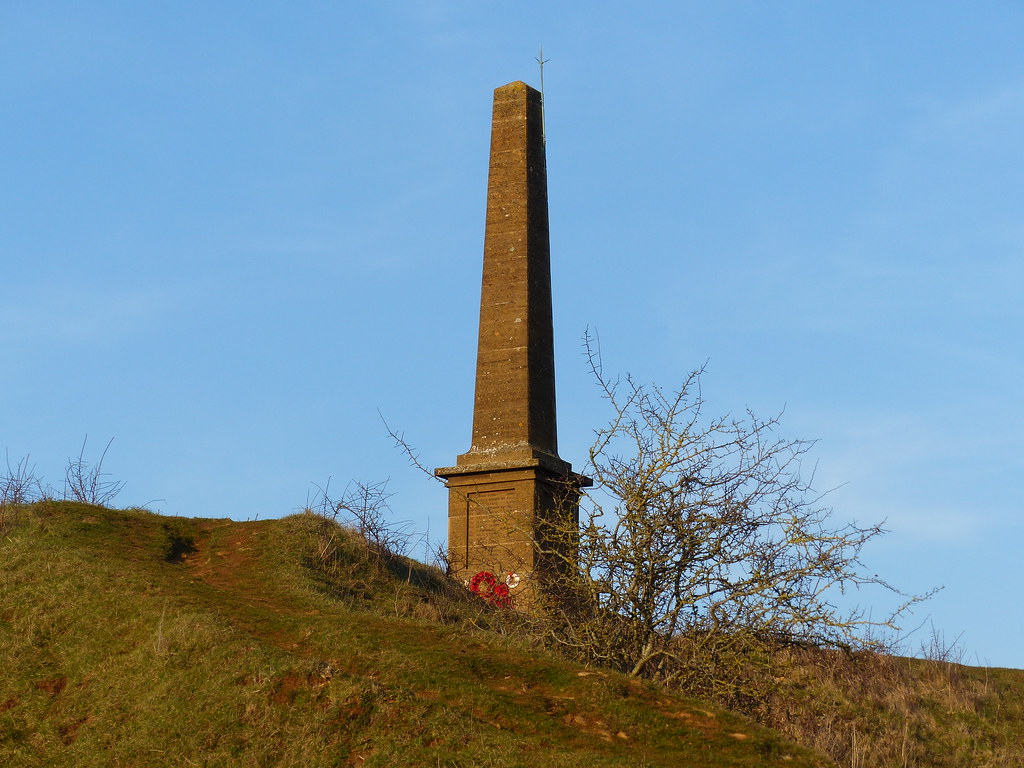
Stoke-sub-Hamdon: War Memorial (Somerset); via Flickr: https://www.flickr.com/photos/13706945@N00/25593196757
In Somerset, Private Ralph is commemorated on the Stoke-sub-Hamdon war memorial, which stands proudly on Ham Hill adjacent the famous quarries, as well as on the war shrine in the Church of St Mary. His name also features on the Bath and Wells Diocesan Association memorial in Bath Abbey. The Stoke bellringers attended the dedication of the Association memorial in July 1921, with their day out taking on some of the characteristics of a ringing outing [17]:
STOKE-SUB-HAMDON.
STOKE BELL RINGERS spent a very enjoyable day on Saturday last, leaving Stoke at 7 a.m. for Bath, where in the Abbey a memorial service was held in memory of the ringers who had fallen in the war. On the tablet was one from Stoke, George Ralph, who was always a very keen ringer at Stoke. During the journey the ringers very much enjoyed sounding the bells at the different towers. Returning round Midsomer Norton and Wells the party reached home about 11 p.m.
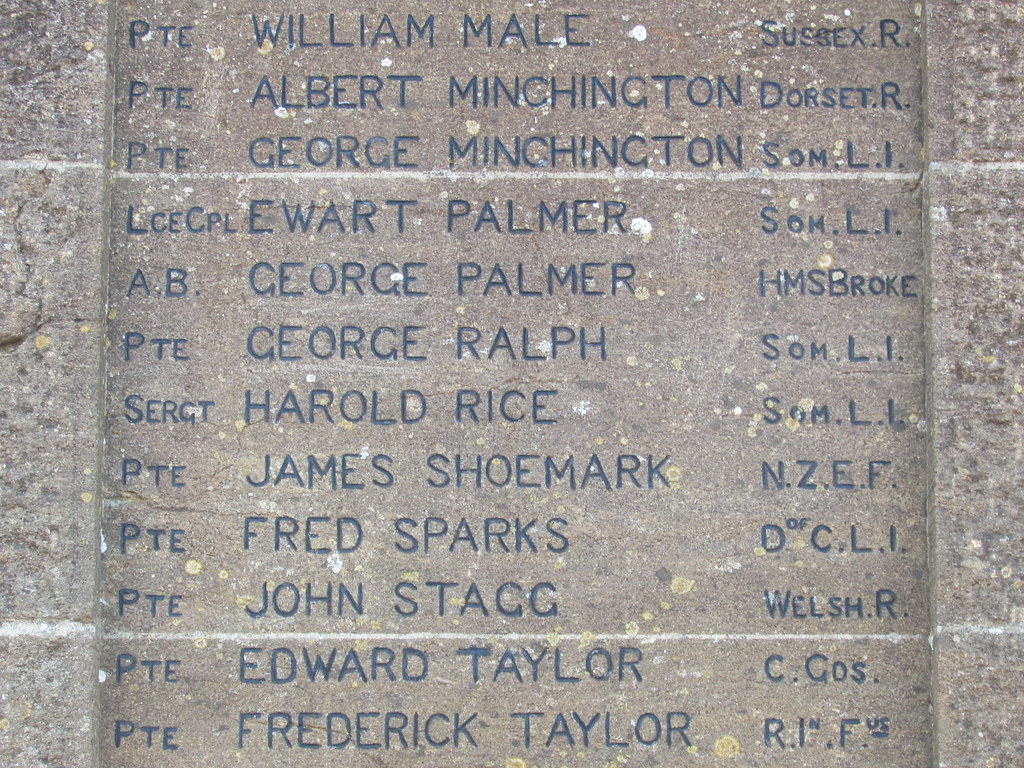
Stoke-sub-Hamdon: Private Ralph’s name on the war memorial (Somerset); via Flickr: https://www.flickr.com/photos/13706945@N00/25593222387
Walter George Ralph and his family:
Walter George Ralph was born at Stoke-sub-Hamdon (Stoke-under-Ham) in the second quarter of 1890, the youngest child of John Ralph and his second wife Emma Ralph (née Smith).
John Ralph. George Ralph’s father, had been born at Martock (Somerset) in 1841, the son of Job and Elizabeth Ralph. He was baptised there on the 11th July 1841. Based on various census returns, the family remained living in Martock throughout John’s childhood. For example, at the time of the 1861 Census, the famly were living at Water Street, Martock, where Job Ralph (George’s grandfather) was a forty-eight-year-old agricultural labourer, and Elizabeth Ralph a forty-seven-year-old glove maker. At the time, John Ralph was nineteen years old and working as an agricultural labourer. He was the eldest of Job and Elizabeth’s five children, who also included: Walter (13, a servant domestic), Mary A. (10), Sarah (8), and Eliza (5).
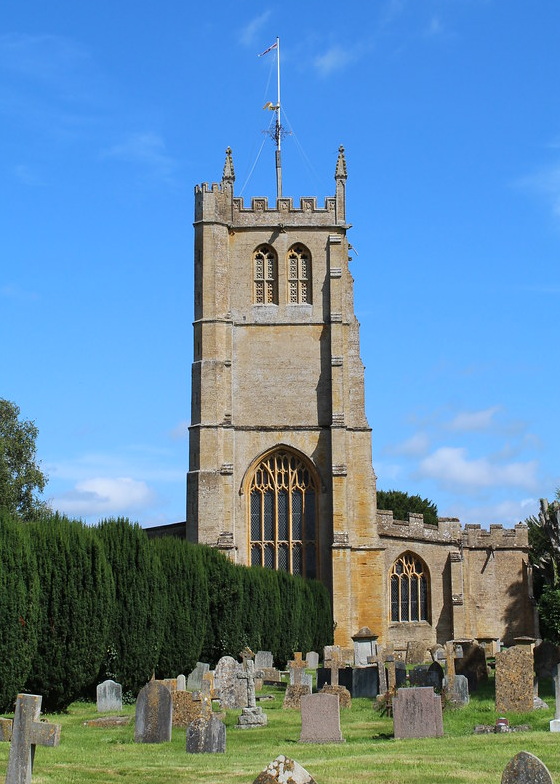
Martock (Somerset): the Church of All Saints, where George Ralph’s father was baptised in 1841; via Flickr: https://www.flickr.com/photos/13706945@N00/51379614425
John Ralph married Eliza Rogers at Martock on the 26th July 1866. Eliza had been born in Devon, but by 1861 was living at Water Street, Martock, with her uncle and aunt, John and Susan Mitchell. At the time, she was eighteen-years old and working as a glove maker. By the time of the 1871 Census, John and Eliza had moved to Preston Plucknett, near Yeovil. John was twenty-nine-years-old, Eliza was twenty-eight and still working as a glover. Based on BMD records and census returns, it seems that they had at least three children:
- Susan Regina, born 1868, died 1878, aged 10
- William Ernest, born 1871
- Elizabeth Sarah, born 1873
Unfortunately, Eliza Ralph died in 1873 and was buried at Martock on the 29th October 1873. John Ralph then married Emma Smith in the third quarter of 1877, proabably at Martock [18].

Sydling St Nicolas (Dorset): The Church of St Nicholas, where George Ralph’s mother was baptised in 1849; via Flickr: https://www.flickr.com/photos/13706945@N00/14819963644
Emma Smith had been born at Sydling St Nicholas (Dorset) in the third quarter of 1849, the daughter of Daniel and Maria Smith. She was baptised at Sydling on the 21st October 1849. Census returns from 1851 and 1861 record the family still living at Sydling, but by the time of the 1871 Census, they had moved to Montacute (Somerset), living in cottages adjoining the Abbey. At the time, Emma Smith was twenty-one years old.
By the time of the 1881 Census, John and Emma Ralph had married and were living at Ham Hill, Stoke-sub-Hamdon. John was thirty-nine and working as a labourer, while Emma was thirty-two. Living with them were three children: William (aged 10), who was the product of John’s earlier marriage with Eliza, and then Daniel T. (aged 2) and Elizabeth A. (1 month), both of whom had been born at Stoke.
According to the 1891, 1901 and 1911 Censuses, the Ralph family continued to live at Stoke-sub-Hamdon for several decades, where John Ralph worked as a gardener and sexton. The 1911 Census recorded that John and Emma Ralph had been married for thirty-three years and that three of their five children were still living. From BMD records and census returns, their children would appear to be:
- Daniel Tom, born 1879, died 1883, aged 4
- Elizabeth Annie, born 1881
- Ellen Maria, born 1886, died 1890, aged 4
- Frederick Arthur, born 1888
- Walter George, born 1890
From the census returns, it seems that the children were usually known by their second names.
By the time of the 1911 Census, George was the only one of the children to still be living at the family home. At the time, he was twenty-one-years old and working as a stone mason, presumably a post linked to the well-known quarries on Ham Hill. It may have been his father’s involvement with the church as Sexton, that had persuaded George to learn to ring the bells.

Stoke-sub-Hamdon (Somerset): The name of Pte G. Ralph features on the left-hand panel of Stoke-sub-Hamdon’s Roll of Honour in St. Mary’s Church; the memorial is a war shrine of the type manufactured and marketed by Messrs. Hughes, Bolckow, & Co. Ltd. of Blyth, usually made from wood recovered from the former training ship HMS Britannia; via Flickr: https://www.flickr.com/photos/13706945@N00/50960441573
We know from the Western Chronicle reports already quoted that Private Ralph was one of several men from Stoke-sub-Hamdon to join-up on the outbreak of war. His service records do not seem to have survived, so it is not possible to find out that much about his service history. The Soldiers Died in the Great War database records that he enlisted at Yeovil. In December 1915, he featured in the Nominal Roll of No. 2 Company, which forms part of War Diary of the 6th Somersets [19].
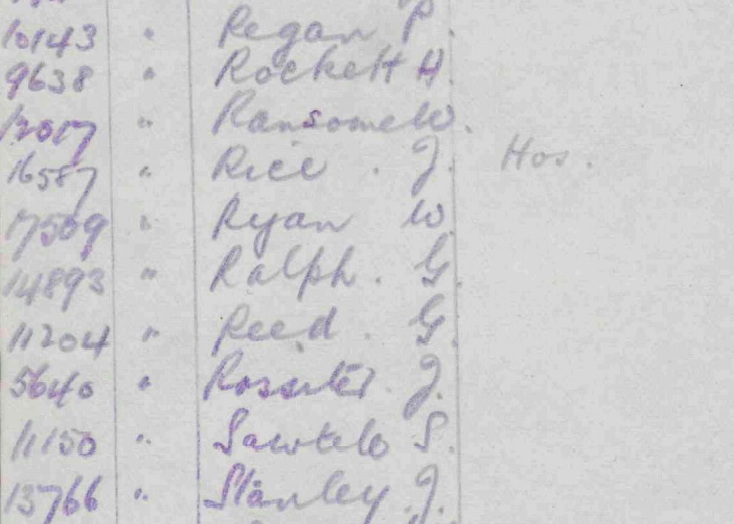
The name of 14893 Pte. Ralph, G. in Nominal Roll of No. 2 Company, 6th Somerset L.I., ca. December 1915, Source: WO 95/1909/1, 6th Battalion, Somerset Light Infantry War Diary, The National Archives, Kew. © Crown Copyright.
We also know, from the Western Chronicle of the 21 January 1916, that he had spent some time at home on leave at the beginning of 1916 [20]:
STOKE-UNDER-HAM.
[…]
HOME ON LEAVE.
Stoker Tom George, R. N. has been home on leave, after serving on one of His Majesty’s ships in the Dardanelles.
The following are home from France Lance-Corpl. Bert Denman, R.E., Pte. George Ralph, S.L.I., Pte. Gilbert Trott, S.L.I.
Walter George Ralph’s parents both died in the 1920s: John on the 22 February 1923, aged 82, and Emma on the 15th July 1925. Both are buried in the churchyard at Stoke. As sexton at Stoke for many years, John received a lengthy obituary in the Western Chronicle [21]:
DEATH AND FUNERAL OF MR. JOHN RALPH.
The news of the death of Mr. John Ralph on Thursday last was received with general regret in Stoke. For over 30 years he had been well-known and well beloved as the sexton of St. Mary’s Church. He had served loyally five successive Vicars and, of late years, he had been a picturesque old man, active in mind and body, full of ready wit and devoted to the beautiful old church, every stone of which he seemed to know and love. His kindly disposition and delightful sense of humour accompanied, as might be expected, a religious faith which was as deep as it was unostentatious. He leaves a widow, two daughters, and two sons to mourn their loss. – On Sunday morning the Vicar, in his sermon, spoke of Mr. Ralph as a regular communicant and a man of real, and not surface, piety. On Sunday evening the Lord Bishop of Bath and Wells, before his sermon, referred to Mr. Ralph’s devoted work. The funeral on Monday was attended by a large number of people. The body was met at the church gate by the Vicar and the choir. As the procession entered the church the 90th Psalm was beautifully and feeling [sic] chanted. After the Lessons the hymn, “They whose course on earth is o’er” (A. and M. 538) was sung, and the other hymn was “Now the Labourer’s task is o’er.” Before the body was carried out of the church the “Nunc Dimittis” was sung, followed by the playing of the Dead March in Saul. After the service a muffled peal was rung on the bells. Deceased was in his 82nd year.
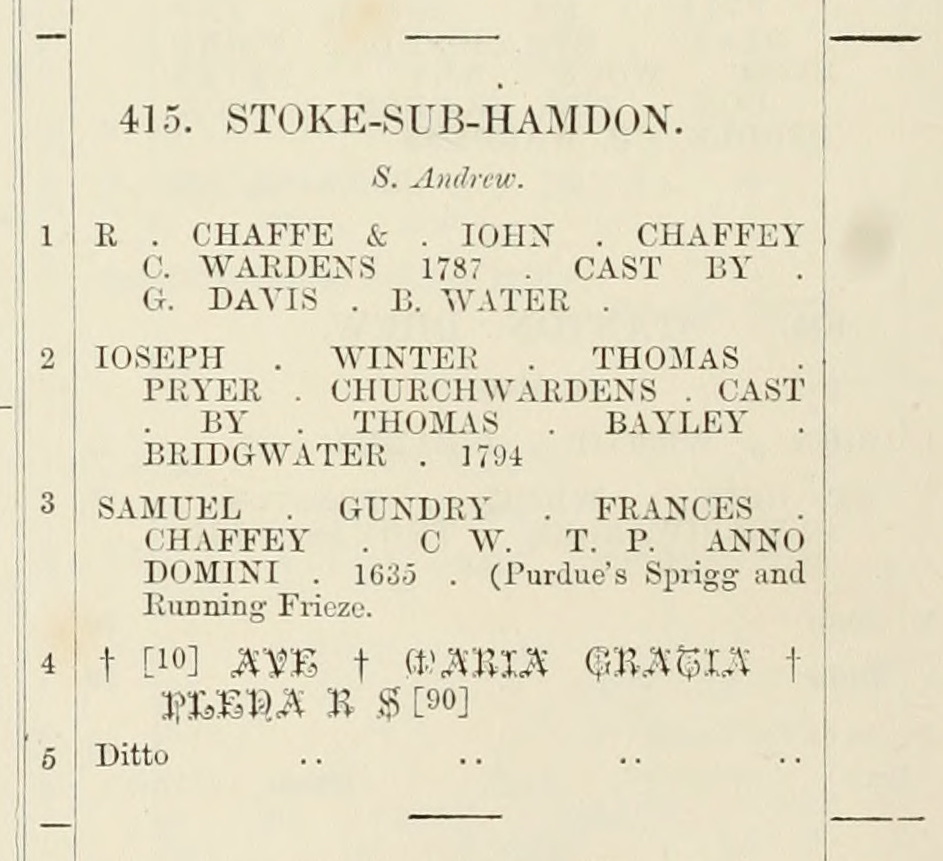
Details of Stoke-sub-Hamdon bells. From: Henry Thomas Ellacombe, The Church Bells of Somerset (1875), p. 80: https://archive.org/details/churchbellsofglo00ella/page/n97
Bells and bellringing at Stoke-under-Ham:
In his 1875 publication on The Church Bells of Somerset, the Rev. Henry Thomas Ellacombe recorded that Stoke-sub-Hamdon had five bells: two of them of pre-reformation date, another cast by Thomas Purdue of Closworth in 1635, the remaining two cast at Bridgwater in the late-eighteenth-century [22]. The ring was restored in 1910. The Western Chronicle printed a rather lengthy account of the rededication service [23]:
RE-OPENING OF THE CHURCH TOWER AND BELLS.
THE HISTORY OF THE BELLS.On Thursday afternoon, the re-opening of the tower and bells of the Church of St. Mary, East Stoke, took place. Owing to their unsafe condition the bells have not been rung for about 33 years as will be seen from the following extract from the vestry book:- April 2nd, 1877. After personally inspecting the bells, it was proposed by Mr Jno. Walter and seconded by Mr James Staple, that Mr Walter Walter be requested to have the said bells examined by a competent person, and that, in view of their apparently dangerous condition, they be not again rung until after such examination, or until further notice. This was carried unanimously. (Signed) F. Shepherd, Chairman; Walter Jno. Walter, Churchwarden; John W. Walter, J. A. Turner.” There is no further reference to the bells in the Vestry Book. About last October the Rector (the Rev. G. G. Monck) expressed a wish that the bells and tower should be examined with a view to their again being placed in a safe condition. The peal consists of five bells, and after an examination it was found that four of the bells would have to be rehung, whilst the second bell would have to be recast, on account of its being cracked in the crown. The work was commenced almost immediately, and so enthusiastically has the project been taken up that between £90 and £100 has already been raised towards the cost.
The work of re-hanging the peal was entrusted to Messrs Doble of Taunton, who have carried out the work in a highly creditable manner. The old cages have been strengthened by long tie bolds and strong corner plates. The bells have been quarter-turned, and are all hung with new fittings on the most up-to-date principle. A new deadening floor has been put in under the bells and various other improvements effected. The inscription on the new bell, which was recast by Messrs. Taylor, of Loughborough, is as follows: “1910: G. G. Monk, vicar; W. Wakely and W. Taylor, churchwardens.”
The work of repairing the interior of the tower and rehanging the bells was carried out under the supervision of Mr C. B. Benson, M.S.A., of Yeovil.
The inscriptions on the bells, previous to their being re-hung, were as follows:– No I (Treble) – “Richard Chaffey and John Chaffey, C. Wardens, 1787. Cast by G. Davis, B’water. No II. – Joseph Winter and Thomas Pryer, Churchwardens.” Cast by Thomas Bayley, Bridgewater, 1764 [i.e. 1794]. No. III. – Ave Maria gratia plenia (sic) R.S.” No. IV. – The same. These two are pre-reformation bells, cast by Roger Simpson [i.e. Semson], of Taunton, about 1549. No. V. (Tenor). – Samuel Gundery, Frances Chaffey, C.W., T.P. Anno Domini 1688.” – Thomas Purdue was the famous Closworth bell founder, who died and was buried there Sept., 1711.DEDICATION CEREMONY.
The dedication ceremony took place in the church in the early afternoon, and was performed by the Ven. Archdeacon Brymer, the other clergy present being the Rector (the Rev G. G. Monck), the Revs L. R. Cotter (West Coker), J.D. D. Keilor (East Chinnock), and J. Harrison (Martock). After prayer had been offered by the Archdeacon, the churchwardens, the bellringers, and the clergy proceeded to the belfry, where the dedication ceremony was performed by the Ven. Archdeacon, the hymn, “O thanks be to Thee our Gracious Lord” being sung meanwhile by the congregation. The Archdeacon afterwards delivered a suitable discourse. He said they had just dedicated their bells to the glory of God and to the use of that church. The bells had practically been unsafe and silent for over 30 years. The first use to which their bells should be put was that of calling the parishioners to the service in God’s house. When they heard the bells giving out their invitation to come to church, surely they should be reminded of one of the great lessons of Ascensiontide – “Lo, I am with you alway, even unto the end of the world.” Christ was present everywhere. They had His special promise – “where two or three are gathered together in My name there am I in the midst of them.” If they more frequently bore that in mind and remembered this great promise they would more readily and more anxiously obey their bells and accept their invitation. When they heard the bells ringing out their joyful peal for holy matrimony they should remember that as Christ adorned and beautified by His presence the marriage in Cana of Galilee, so he was also present at their marriage services in church and would bless and sanctify those marriages which were undertaken reverently, discreetly and in the hearing of God. If they heard the solemn knell sound for a parting soul, they should bear in mind that some day – they knew not when – that the same solemn knell would sound for each one of them.
After the service some half pull changes were rung on the bells by members of the Bath and Wells Diocesan Association of Ringers, the following towers being represented:- Taunton St. Mary and St. James’s, Bridgwater St Mary’s, Martock, Odcombe, Montacute, Norton-sub-Hamdon, and the home band.
At 5 p.m. a public tea was held in the Church School. In the evening a service was held in the church, the Rev. Preb. J. Phelips (Vicar of Yeovil) being the preacher. Collections were made to liquidate the debt on the bell, which stands at £74.
The reference to half-pull ringing means that the Diocesan Association bellringers were performing change ringing, by contrast to round ringing or whole-pull ringing (call changes). The tribute to George Ralph put together by the village of Stoke-sub-Hamdon to mark the centenary of the First World War includes the information that he was part of a village band that had rang two 720s of Grandsire Doubles at Stoke during 1913, the first time for a marriage, and then again on Easter Day [24]. This means that the Stoke band had made considerable progress in developing their change-ringing skills since the rehang.
More work was undertaken on the Stoke bells in 1949, when the ring was augmented to six and the bells tuned and rehung in a new iron frame by Messrs. John Taylor and Co. of Loughborough [25]. One of the medieval bells cast by Roger Semson seems to survive in the current ring of six at Stoke.
Note:
There is more information on Private George Ralph, including a photograph, in the excellent tribute put together by the village of Stoke-sub-Hamdon to mark the centenary of his death: http://www.stoke-sub-hamdon.co.uk/centenary-great-war/george-ralph/
References:
[1] A major source for this post has been the genealogical resources made available by Findmypast (£): https://www.findmypast.co.uk
[2] The Long, Long Trail: Prince Albert’s (Somerset Light Infantry): https://www.longlongtrail.co.uk/army/regiments-and-corps/the-british-infantry-regiments-of-1914-1918/prince-alberts-somerset-light-infantry/
[3] The Long, Long Trail: 14th (Light) Division: https://www.longlongtrail.co.uk/army/order-of-battle-of-divisions/14th-light-division/
[4] WO 95/1903/2, 6th Battalion, Somerset Light Infantry War Diary, The National Archives, Kew.
[5] Wilfrid Miles, Military Operations: France and Belgium, 1916: 2nd July 1916 to the end of the Battles of the Somme, History of the Great War based on Official Documents (London: Macmillan, 1938), p. 321; via Internet Archive: https://archive.org/details/in.ernet.dli.2015.210680/page/n451
[6] Ibid., pp. 326-327: https://archive.org/details/in.ernet.dli.2015.210680/page/n455
[7] Ibid., pp. 329-330: https://archive.org/details/in.ernet.dli.2015.210680/page/n459
[8] A typical example would be in The Westminster Gazette, 18 September 1916, p. 2; via British Newspaper Archive: “And we get a further idea of the astonishment created by the new weapon in the report of the airman who sent the wireless message, ‘A tank is walking up the high street of Flers with the British Army cheering behind.'”
[9] Robin Prior and Trevor Wilson, The Somme (New Haven, CT. and London: Yale University Press, 2005), p. 237.
[10] Ibid., p. 239.
[11] Miles, p. 351: https://archive.org/details/in.ernet.dli.2015.210680/page/n481
[12] WO 95/1903/1, 43rd Infantry Brigade Headquarters War Diary, The National Archives, Kew.
[13] Western Chronicle, 3 November 1916, p. 6; via British Newspaper Archive.
[14] Western Chronicle, 2 February 1917, p. 5; via British Newspaper Archive.
[15] Western Chronicle, 27 July 1917, p. 7; via British Newspaper Archive.
[16] NAA: B2455, BAXTER S R, National Archives of Australia, Canberra, ACT; via NAA RecordSearch (NameSearch): https://recordsearch.naa.gov.au
[17] Western Chronicle, 8 July 1921, p. 11; via British Newspaper Archive.
[18] D/P/MART 2/2/2, Somerset Banns Index, Somerset Archives; via Findmypast
[19] WO 95/1909/1, 6th Battalion, Somerset Light Infantry War Diary, The National Archives, Kew.
[20] Western Chronicle, 21 January 1916, p. 8; via British Newspaper Archive.
[21] Western Chronicle, 2 March 1923, p. 10; via British Newspaper Archive.
[22] Henry Thomas Ellacombe, The church bells of Somerset, to which is added an olla podrida of bell matters of general interest (Exeter: William Pollard, 1875), p. 80; via Internet Archive: https://archive.org/details/churchbellsofglo00ella/page/n97
[23] Western Chronicle, 13 May 1910, p. 6; via British Newspaper Archive.
[24] Stoke sub Hamdon Village Website: George Ralph’s story: http://www.stoke-sub-hamdon.co.uk/centenary-great-war/george-ralph/
[25] The Ringing World, 14 October 1949 p. 495; via CCCBR Library: http://cccbr.org.uk/wp-content/uploads/2018/07/rw1949.pdf

[…] from Delville Wood towards the village of Gueudecourt. Another member of the Association, 14893 Private Walter George Ralph of the 6th Battalion, Somerset Light Infantry, a bellringer from Stoke-sub-Hamdon (Stoke-under-Ham), would be killed in action the following day. […]
By: Private George Bye, 8th Battalion, Bedfordshire Regiment | Opusculum on September 16, 2021
at 10:38 am
[…] on a fortified position known as the Quadrilateral. Another member of the Association, 14893 Private Walter George Ralph of the 6th Battalion, Somerset Light Infantry, a bellringer from Stoke-sub-Hamdon (Stoke-under-Ham), would be killed in action the following day. […]
By: Private Albert Budd, 9th Battalion, King’s Royal Rifle Corps | Opusculum on September 16, 2021
at 10:40 am
[…] Ralph (Stoke under Ham): Private Walter George Ralph (Service No: 14893), 6th Bn., Somerset Light Infantry; died 16 September 1916, aged 27; buried in […]
By: The war memorial of the Bath and Wells Diocesan Association of Change Ringers in Bath Abbey | Opusculum on September 16, 2021
at 10:42 am